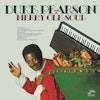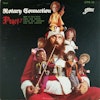The raw, low-down, and dirty jazz-R&B-blues Christmas album is a thing, a hopping holiday tradition in league with mistletoe kissing and dosing the eggnog with much-too-much brandy. And whiskey. And cognac.
Among the ballsy Christmas collections of a pre–twenty-first-century vintage that unceasingly please the feet, the heart, and the soul, there is vocalist Lou Rawls’s Merry Christmas. Ho! Ho! Ho!, Rotary Connection’s Peace, Jimmy Smith’s Christmas ’64, Ramsey Lewis Trio’s Sound of Christmas, the Temptations’ Christmas Card, every Christmas-y album that James Brown ever made, Bob Dorough with the Miles Davis Sextet’s “Blue Xmas (To Whom It May Concern),” and, for good measure, let’s throw in the legendary Florida singer King Coleman’s “Blue Grey Christmas” single. Why stand on ceremony? It’s a holiday.
One recording that sticks out as much for the man as for its marvel is hard bop avatar, pianist, and celeste player (!?!) Duke Pearson’s Merry Ole Soul.
Before celebrating Christmas with Duke, you have to know a little bit about his role in Blue Note’s development as a home of hard bop starting at the top of the ’60s. As a songwriter, Pearson was the chilled pianist behind scribing Lee Morgan’s “Sweet Honey Bee,” Donald Byrd’s “Cristo Redentor,” Cannonball Adderley’s “Tribute to Brownie,” and Oscar Brown Jr.’s “Jeannine,” the latter of which was cowritten with the singer.
As an arranger, the mesmerizing “Cristo Redentor,” was but just one of four songs that Pearson put together for Byrd based on the pianist’s time in Brazil with vocalist Nancy Wilson for whom he played on tour. Pearson’s arranged quartet of songs for eight-voice choir and jazz septet became Byrd’s aptly titled A New Perspective of 1964, an uplifting, leveled, complex sound that shifted the vibe and spirit of jazz’s future, as well as Pearson’s as the pianist also became Blue Note’s A&R boss for a time.
Ten years into his start making leader albums for Blue Note with 1960’s Profile—a decade of touchstones including 1965’s Wahoo! and 1968’s The Phantom—comes Merry Ole Soul.
Overlooked as an often sweat-less, un-daring pianist (at the very least in relationship to his inventive, risk-taking sensibilities as an arranger), I counter that opinion and use the richly dynamic Merry Ole Soul as an example. Piquant, fussy, but funky, Pearson just happens to use his head as much as his soul when it comes to frenetically grooving through the wheels-off and wild rhythms of “Santa Claus Is Coming to Town.”
Then again, it couldn’t be too difficult, or even undesirable, fitting into a bear of a beat such as Pearson’s whimsical “Santa” (and his “Salt Peanuts” piano riffs) when you have bassist Melbourne Robert Cranshaw, Philly’s favorite drumming son Mickey Roker, and percussionist Airto Moreira beside you for six months of Van Gelder Studio, Englewood Cliffs, New Jersey, session time.
Maybe stating that Pearson uses as much brains as he does brawn makes him something of a Wynton Kelly–meets–Lennie Tristano–type pianist. Yeah? And? It is those equal doses of elegance, strength, and smarts that make him so studiously dexterous and capable of turning a dainty keyboard such as the celesta—a struck idiophone with the faint tone of a bell—into something mighty and expressive.
On composer James Pierpont’s “Jingle Bells,” Pearson perfects a Latin rhythmic halt at the carol’s start, accompanied, singularly, by percussionist Airto’s whooshing, breathing, squeaking signature. As the wood block’s tock heightens and the timbale tightens, so does Roker and Cranshaw’s off-the-beat syncopation. And with that, Pearson is off on his own weird ride.
“Sleigh Ride,” the Leroy Anderson–Mitchell Parish Christmas classic, finds Pearson introducing the track with a connect-the-dots plonk to his piano while his celeste tinkles a wintry seasonal set of bell tones. As Cranshaw applies a rubber band-y bass line, Pearson finds a blue mood for both keyboards to solo, then criss-cross, in a showy fashion resembling McCoy Tyner playing Fred Rogers’s Neighborhood theme music. Woolly stuff. Sticking to the muzzy blues, but with a slow-stepping, gospel-inspired inflection in Pearson’s piano’s pronouncement is “Silent Night,” a slack track where Roker works his brushes and snare like a buzzing barfly for an even woozier overall effect. Roker too is responsible for setting the flywheel pace and manic, military rhythm on (no doubt) “Little Drummer Boy.” With Cranshaw laying back in his own pocket, and Pearson specking the snow-scape at will with an atonal take on the traditional melody, Roker has the lion’s share of the riddling para-diddling fun.
With that, you get the true spirit of the holiday as well as Pearson’s inner vibe—a generous producer and collaborator altogether too willing to let his costars share in the holiday cheer while making merry with his own un-keyed reverie.


